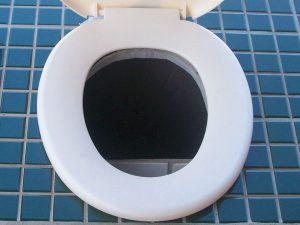We want to spread the word about compost toilets, and so they have to be pleasant to use. A smelly, dirty, uncomfortable compost toilet doesn’t spread the word at all – quite the opposite. You shouldn’t see anything nasty, or have flies escape when you open the lid. You can apply the ‘granny test’ – if someone’s granny will happily use it, you’ve succeeded. The more well-built and well-maintained compost toilets there are, the more people will come to accept them.
People will not be familiar with them; gently introduce guests to the idea, and make sure there are clear instructions on the wall. It may be a good idea to make some notes on the use and maintenance of your compost toilet, to be handed over to future owners, tenants or house-sitters. Do remember to throw a handful of soak down after every use, and don’t throw anything else down, like sanitary towels or disposable nappies.
Starting off
Put around 10cm of sawdust in the bottom of the chamber. Some say it’s a good idea to add a shovelful of soil. The millions of bacteria, fungi, moulds and other micro-organisms in soil will kick-start the composting process. Not sure about this one; the soil could contain the eggs of flies, fungus gnats, mites, or other creatures you really don’t want at this stage (it’s fine when you seal the toilet after a year’s use though). We didn’t add soil at the beginning, and it certainly didn’t hinder the composting process.
Daily tasks
Clean, check toilet paper etc. All the things you’d do with a conventional toilet, in other words. This is very important, in fact more so than an ordinary loo, because some people will be a bit scared of it. It needs to be spotless to put people at their ease.
Check the sawdust in the bucket. Top up if necessary. If you have run out of sawdust, then get some more from a friendly sawmill / wood workshop. If you chainsaw firewood, then bag up the sawdust after every session, and store it in a dry place.
Monthly tasks
Check the seal around the lid. Check whether the ‘peak’ needs to be knocked. As you can imagine, because deposits are dropped in the same place, a little ‘peak’ will build up, which needs to be knocked flat every now and then. You can do this via the hatch or, more easily, via the seat. Keep a special tool separate from the rest, preferably in a locked shed. A hoe is good. Put the hoe down into the chamber and move it from side to side, making sure that you flatten out the pile. Then take it outside and hose it down really well before locking it away again.
Annual tasks
Empty the chamber that has been resting, and decomposing for a year. Take off the hatch, get a long-handled shovel inside and empty the contents into a wheelbarrow. Don’t worry, it will be just like ordinary compost, and there will be much less of it than you expect. This job is best done in winter – the heap will spend the summer breaking down, and if you put it around your fruit trees, flower beds etc, by the time the summer comes around, it will be absorbed into the soil. You can leave it for more than a year if the other chamber isn’t looking full – the longer the waste has to decompose the better. If you can get into a two-year cycle instead of a one-year cycle, then you’re more certain to end up with good crumbly compost at the end.Take the seat off the chamber you’ve been using, and put it onto the now empty chamber. Fix the blank plate over the first chamber and leave it for a year to decompose.
Before you fix the blank plate, you could put a shovelful of worms into the full chamber. You can’t do this before you’ve finished using it, as the worms don’t like the salts in urine. But when you’ve finsished using it it’s OK. Don’t use worms from your garden – composting worms are different from earthworms, and are not found in soil – you can get them from your compost heap, or even from your septic tank if you have one. There are special composting worms that are smaller than earthworms, reddish in colour and with different shaded bands. There are brandling worms, tiger worms, and best of all – dendra worms (because they like to eat sawdust), and If you can’t find any in your compost heap, you can order some online – they come through the post! They will not only munch their way through the waste (breaking it down into smaller particles for micro-organisms to get at more easily), their digestive system will break down material to provide nutrients for plants, and they make tunnels which will allow air into the pile and provide oxygen for the aerobic micro-organisms. You can experiment with worms – put some in when you start, then see if they are still there when you empty the finished compost.
Check that the drain is clear. You can clear it with a small drain rod if not.

